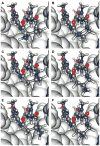Next generation hairpin polyamides with (R)-3,4-diaminobutyric acid turn unit
- PMID: 18459783
- PMCID: PMC3063708
- DOI: 10.1021/ja800888d
Next generation hairpin polyamides with (R)-3,4-diaminobutyric acid turn unit
Abstract
The characterization of a new class of pyrrole-imidazole hairpin polyamides with beta-amino-gamma-turn units for recognition of the DNA minor groove is reported. A library of eight hairpins containing ( R)- and ( S)-3,4-diaminobutyric acid (beta-amino-gamma-turn) has been synthesized, and the impact of the molecules on DNA-duplex stabilization was studied for comparison with the parent gamma-aminobutyric acid (gamma-turn) and standard ( R)-2,4-diaminobutyric acid (alpha-amino-gamma-turn)-linked eight-ring polyamides. For some, but not all, sequence compositions, melting temperature analyses have revealed that both enantiomeric forms of the beta-amino-gamma-turn increase the DNA-binding affinity of polyamides relative to the ( R)-alpha-amino-gamma-turn. The ( R)-beta-amine residue may be an attractive alternative for constructing hairpin polyamide conjugates. Biological assays have shown that ( R)-beta-amino-gamma-turn hairpins are able to inhibit androgen receptor-mediated gene expression in cell culture similar to hairpins bearing the standard ( R)-alpha-amino-gamma-turn, from which we infer they are cell-permeable.
Figures







Similar articles
-
Alpha-diaminobutyric acid-linked hairpin polyamides.Bioorg Med Chem. 2007 Nov 15;15(22):6927-36. doi: 10.1016/j.bmc.2007.07.019. Epub 2007 Aug 22. Bioorg Med Chem. 2007. PMID: 17869122 Free PMC article.
-
Base pair recognition of the stereochemically alpha-substituted gamma-turn of pyrrole/imidazole hairpin polyamides.J Am Chem Soc. 2006 Nov 22;128(46):14905-12. doi: 10.1021/ja064369l. J Am Chem Soc. 2006. PMID: 17105301
-
Discrimination of hairpin polyamides with an alpha-substituted-gamma-aminobutyric acid as a 5'-TG-3' reader in DNA minor groove.J Am Chem Soc. 2006 Jul 12;128(27):8766-76. doi: 10.1021/ja0580587. J Am Chem Soc. 2006. PMID: 16819870
-
Targeting the minor groove of DNA.Curr Opin Struct Biol. 1997 Jun;7(3):355-61. doi: 10.1016/s0959-440x(97)80051-6. Curr Opin Struct Biol. 1997. PMID: 9204277 Review.
-
Sequence-specific DNA binding Pyrrole-imidazole polyamides and their applications.Bioorg Med Chem. 2018 May 1;26(8):1393-1411. doi: 10.1016/j.bmc.2018.01.026. Epub 2018 Feb 1. Bioorg Med Chem. 2018. PMID: 29439914 Review.
Cited by
-
Characterization and solubilization of pyrrole-imidazole polyamide aggregates.J Med Chem. 2012 Jun 14;55(11):5425-32. doi: 10.1021/jm300380a. Epub 2012 May 24. J Med Chem. 2012. PMID: 22607187 Free PMC article.
-
Structural basis for cyclic Py-Im polyamide allosteric inhibition of nuclear receptor binding.J Am Chem Soc. 2010 Oct 20;132(41):14521-9. doi: 10.1021/ja105068b. J Am Chem Soc. 2010. PMID: 20812704 Free PMC article.
-
RNA polymerase II trapped on a molecular treadmill: Structural basis of persistent transcriptional arrest by a minor groove DNA binder.Proc Natl Acad Sci U S A. 2022 Jan 18;119(3):e2114065119. doi: 10.1073/pnas.2114065119. Proc Natl Acad Sci U S A. 2022. PMID: 35022237 Free PMC article.
-
Binding studies of a large antiviral polyamide to a natural HPV sequence.Biochimie. 2014 Jul;102:83-91. doi: 10.1016/j.biochi.2014.02.011. Epub 2014 Feb 26. Biochimie. 2014. PMID: 24582833 Free PMC article.
-
Enhancing the cellular uptake of Py-Im polyamides through next-generation aryl turns.Nucleic Acids Res. 2012 Mar;40(5):2345-56. doi: 10.1093/nar/gkr970. Epub 2011 Nov 12. Nucleic Acids Res. 2012. PMID: 22080545 Free PMC article.
References
-
- Olenyuk BZ, Zhang GJ, Klco JM, Nickols NG, Kaelin WG, Dervan PB. Proc Natl Acad Sci USA. 2004;101:16768–16773. - PMC - PubMed
- Nickols NG, Dervan PB. Proc Natl Acad Sci USA. 2007;104:10418–10423. - PMC - PubMed
- Nickols NG, Jacobs CS, Farkas ME, Dervan PB. ACS Chem Biol. 2007;2:561–571. - PMC - PubMed
-
- Kielkopf CL, White S, Szewczyk JW, Turner JM, Baird EE, Dervan PB, Rees DC. Science. 1998;282:111–115. - PubMed
- Kielkopf CL, Baird EE, Dervan PD, Rees DC. Nat Struct Biol. 1998;5:104–109. - PubMed
- Zhang Q, Dwyer TJ, Tsui V, Case DA, Cho JH, Dervan PB, Wemmer DE. J Am Chem Soc. 2004;126:7958–7966. - PubMed
- Puckett JW, Muzikar KA, Tietjen J, Warren CL, Ansari AZ, Dervan PB. J Am Chem Soc. 2007;129:12310–12319. - PMC - PubMed
-
- Wurtz NR, Dervan PB. Chem Biol. 2000;7:153–161. - PubMed
- Sasaki S, Bando T, Minoshima M, Shimizu T, Shinohara K, Takaoka T, Sugiyama H. J Am Chem Soc. 2006;128:12162–12168. - PubMed
- Tsai SM, Farkas ME, Chou CJ, Gottesfeld JM, Dervan PB. Nucleic Acids Res. 2007;35:307–316. - PMC - PubMed
- Minoshima M, Bando T, Sasaki S, Shinohara K, Shimizu T, Fujimoto J, Sugiyama H. J Am Chem Soc. 2007;129:5384–5390. - PubMed
-
- Poulin-Kerstien AT, Dervan PB. J Am Chem Soc. 2003;125:15811–15821. - PubMed
Publication types
MeSH terms
Substances
Grants and funding
LinkOut - more resources
Full Text Sources
Other Literature Sources

